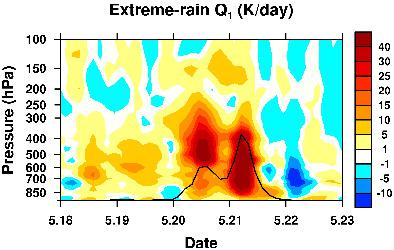当前位置:
X-MOL 学术
›
Q. J. R. Meteorol. Soc.
›
论文详情
Our official English website, www.x-mol.net, welcomes your
feedback! (Note: you will need to create a separate account there.)
Large‐scale dynamic, heat and moisture structures of monsoon‐influenced precipitation in the East Asian monsoon rainy area
Quarterly Journal of the Royal Meteorological Society ( IF 3.0 ) Pub Date : 2020-12-16 , DOI: 10.1002/qj.3956 Chunyan Zhang 1, 2 , Donghai Wang 1, 2 , Zihao Pang 3 , Yu Zhang 4 , Xiaoling Jiang 5 , Zhilin Zeng 1, 2 , Zhenzhen Wu 1, 2
Quarterly Journal of the Royal Meteorological Society ( IF 3.0 ) Pub Date : 2020-12-16 , DOI: 10.1002/qj.3956 Chunyan Zhang 1, 2 , Donghai Wang 1, 2 , Zihao Pang 3 , Yu Zhang 4 , Xiaoling Jiang 5 , Zhilin Zeng 1, 2 , Zhenzhen Wu 1, 2
Affiliation

|
This study investigated large‐scale dynamic structures along with heat and moisture budgets associated with monsoon‐influenced precipitation over a typical rainy domain in the East Asian monsoon region. Large‐scale dynamically and thermodynamically consistent forcing data based on multiple measurements were produced by a one‐dimensional constrained variational analysis method. Using the forcing data, distinct characteristics of large‐scale states were documented for cases of notable pre‐monsoon rainfall before the South China Sea monsoon onset (SCSMO), extreme rainfall during SCSMO, and persistent strong rainfall after SCSMO. The pre‐monsoon period mainly resulted from weak and discrete cloud regimes. The extreme‐rain period was associated with a severe deep convective system moving from the west, and the persistent‐rain period was related to moderate convective cells separated from the strong convective system over the northern South China Sea. Large‐scale features including vertical velocity, wind convergence, and diabatic heating and drying were the strongest (weakest) during the extreme‐rain (pre‐monsoon) period. For the pre‐monsoon and persistent‐rain periods, the period‐averaged profiles of vertical velocity and diabatic heating and drying showed a one‐peak structure. However, during the extreme‐rain period, a leap‐forward mutation was seen in the vertical structure and magnitude of these large‐scale states. The multiple peaks shown in the vertical profiles of vertical velocity and diabatic heating during the extreme‐rain period may indicate various convective cloud systems co‐existed. The diabatic heating profiles of extreme rainfall indicated that the first rainfall peak was related to the successive occurrence of stratiform anvils and convective clouds, while the second rainfall peak, which was most intense, was associated with shallow convective clouds, severe deep convective clouds, and detraining stratiform anvils.
中文翻译:

东亚季风雨区季风影响降水的大规模动力,热力和水分结构
这项研究调查了与东亚季风区典型雨域中季风影响的降水相关的大规模动力结构以及热量和水分的收支。通过一维约束变分分析方法生成了基于多次测量的大规模动态和热力学一致的强迫数据。利用强迫数据,记录了南海季风爆发前明显的季风前降雨,南海季风爆发期间的极端降雨和南海季风爆发之后的持续强降雨的大规模国家的明显特征。季风前期主要是由于薄弱和离散的云系统造成的。极端雨水时期与从西方向移动的严重的深对流系统有关,持续降雨期与南海北部强对流系统分离的中等对流单元有关。在极端降雨(季风前)期间,包括垂直速度,风会聚,非绝热加热和干燥在内的大规模特征最强(最弱)。在季风前和持续降雨期间,垂直速度和非绝热加热和干燥的周期平均剖面显示为一峰结构。然而,在极端降雨时期,这些大尺度国家的垂直结构和规模出现了跳跃式突变。在极端降雨期间,垂直速度和非绝热加热的垂直剖面中显示的多个峰值可能表明各种对流云系统共存。
更新日期:2020-12-16
中文翻译:

东亚季风雨区季风影响降水的大规模动力,热力和水分结构
这项研究调查了与东亚季风区典型雨域中季风影响的降水相关的大规模动力结构以及热量和水分的收支。通过一维约束变分分析方法生成了基于多次测量的大规模动态和热力学一致的强迫数据。利用强迫数据,记录了南海季风爆发前明显的季风前降雨,南海季风爆发期间的极端降雨和南海季风爆发之后的持续强降雨的大规模国家的明显特征。季风前期主要是由于薄弱和离散的云系统造成的。极端雨水时期与从西方向移动的严重的深对流系统有关,持续降雨期与南海北部强对流系统分离的中等对流单元有关。在极端降雨(季风前)期间,包括垂直速度,风会聚,非绝热加热和干燥在内的大规模特征最强(最弱)。在季风前和持续降雨期间,垂直速度和非绝热加热和干燥的周期平均剖面显示为一峰结构。然而,在极端降雨时期,这些大尺度国家的垂直结构和规模出现了跳跃式突变。在极端降雨期间,垂直速度和非绝热加热的垂直剖面中显示的多个峰值可能表明各种对流云系统共存。











































 京公网安备 11010802027423号
京公网安备 11010802027423号